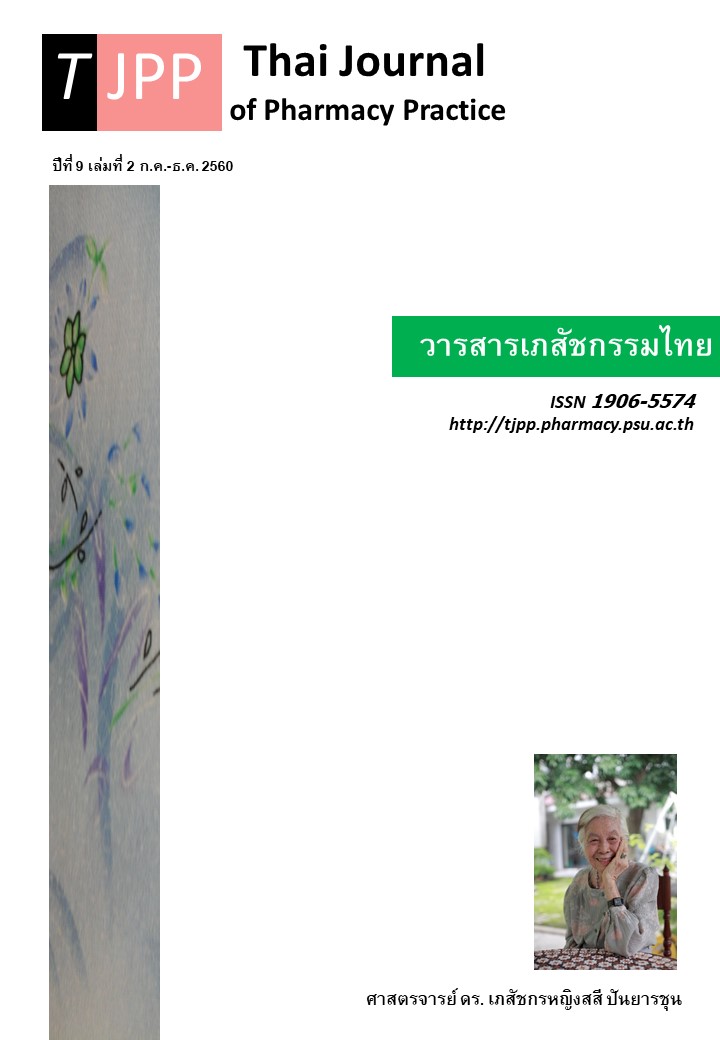Analysis of the Situation on Contamination of Prohibited Harmful Substances in Facial Cosmetics In AmphurNangrong, Buriram Province During 2013-2016
Main Article Content
Abstract
Objective: To study prevalence and distribution of the contamination of prohibited harmful substances in facial cosmetics, to study relationship between various factors and the contamination and to determine probability of contamination of cosmetics. Methods: The researcher used the results from the inspection of cosmetics selling places and the analysis of 143 facial cosmetics with unlawful labels by using the preliminary test kits during the years 2013-2016in Nangrong district, Buriram province. Ability of risk scores to predict contamination of prohibited substances was assessed using the Receiver Operating Characteristic (ROC) curve. Results: Inspection of cosmetics selling places revealed 35.98% of the stores had in their stores cosmetics with illegal labels or dangerous cosmetics according to announcement of Ministry of Public Health. The inspections of shop stalls, cosmetics booths or stores in flea market revealed 95.65, 80.39 and 70 percent of them respectively, sold cosmetics with illegal labels or the dangerous cosmetics. About 54.55 percent of the tested samples were found to contain prohibited substances. Mercury and mercury compounds, retinoic acid and hydroquinone were identified in 35.66%, 18.18%, and 11.89% of the examined cosmetics respectively. Factors significantly related to the contamination of prohibited substance were being sold in cosmetics stores (OR = 11.35), being sold in stalls (OR = 46.57), being sold in retail stores or groceries (OR = 71.11), being sold in wholesalers (OR = 62.45) (when being sold in a beauty salon as a reference group), being white in color (OR = 42.91), being yellow or orange cosmetics (OR = 6.83) (when the beige, egg shell color or being clear or colorless as a reference group), being cream type (OR = 19.28) and having Thai label (OR = 9.51). Risk score for each factor ranged from 0-7. The maximum total risk score for all cosmetic factors was 21. Risk scores can predict contamination of prohibited substances with area under the ROC curve 0.84. Cosmetics with a risk score 10 had a chance of 0.11 times less likely to contain prohibited substances compared to that of total samples. Cosmetics with a risk score 15 were 26.6 times more likely to be contaminated with prohibited substances compared to that of total samples. Conclusion: Cosmetics with unlawful labels are more likely to be contaminated with hazardous substances. The risk score of the cosmetics can be used to select samples for further testing by the authorities and as a guide for consumers to protect themselves in the selection of cosmetics.
Article Details
ผลการวิจัยและความคิดเห็นที่ปรากฏในบทความถือเป็นความคิดเห็นและอยู่ในความรับผิดชอบของผู้นิพนธ์ มิใช่ความเห็นหรือความรับผิดชอบของกองบรรณาธิการ หรือคณะเภสัชศาสตร์ มหาวิทยาลัยสงขลานครินทร์ ทั้งนี้ไม่รวมความผิดพลาดอันเกิดจากการพิมพ์ บทความที่ได้รับการเผยแพร่โดยวารสารเภสัชกรรมไทยถือเป็นสิทธิ์ของวารสารฯ
References
2. Bureau of Cosmetics and Hazardous Substances. Annual report of Bureau of Cosmetics and Hazardous Substances in 2015.Department of Medical Sciences. Ministry of Public Health; 2015.
3. Bureau of Cosmetics and Hazardous Substances. Annual report of Bureau of Cosmetics and Hazardous Substances in 2016. Department of Medical Sciences. Ministry of Public Health; 2016.
4. Boonprachom A, Yukittichai N, Ekkabut N, Pongnimitprasert N, Nuntharatanapong N. Investi- gation of ammoniated mercury and hydroquinone in whitening creams distributed in Amphur Muang Nakhon Pathom province. Thai Bulletin of Pharma-ceutical Sciences 2013; 8: 1-8.
5. Klinsoonthorn N, Nutsatapana C, Khemthong T, Mapradit P. Prohibited substances in acne melas- ma whitening cosmetic products in lower central provinces during 2010-2013. FDA Journal 2013; 20: 28-36.
6. Cosmetic Act B.E. 2558. Royal Gazette No. 132, Part 86A (Sep 8, 2015).
7. Public Health Ministerial Declaration in 2016 on the name of the substances prohibited an ingredient in cosmetics. Royal Gazette No. 133, Part 114D special (May 17, 2016).
8. Public Health Ministerial Declaration in 2016 on specification of cosmetics names banned for manufacturing, import or sale. Royal Gazette No. 133, Part 72D special (March 28, 2016).
9. Wuttiadirek W, Pumket W. Study of mercury levels in whitening creams distributed in Nakhonsawan municipality area. Thai Bulletin of Pharmaceutical Sciences.2013; 8: 1-8.

